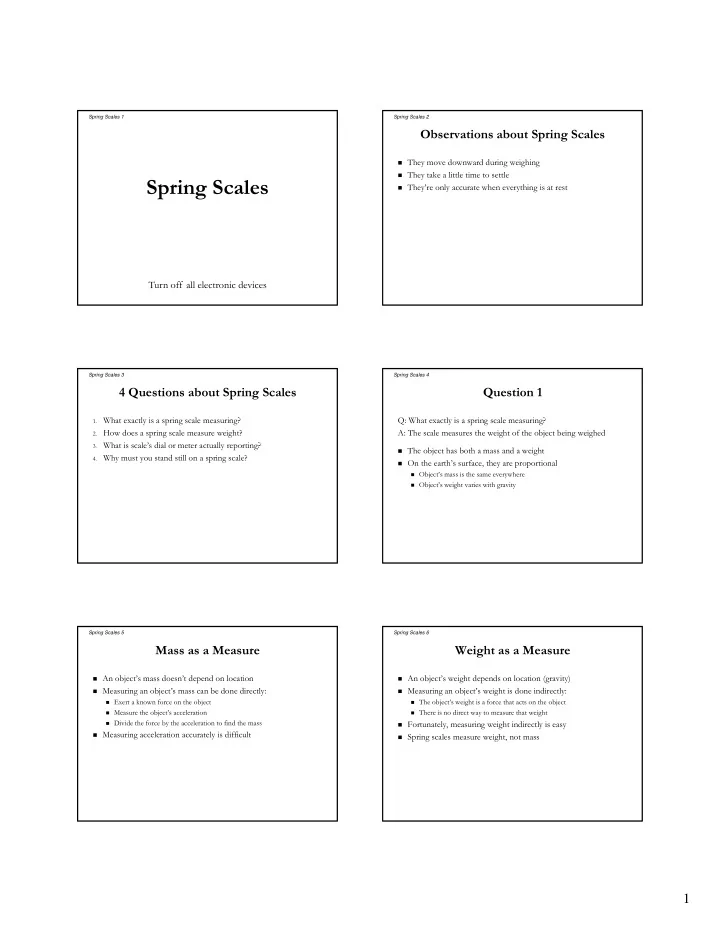

Spring Scales 1 Spring Scales 2 Observations about Spring Scales They move downward during weighing They take a little time to settle Spring Scales They’re only accurate when everything is at rest Turn off all electronic devices Spring Scales 3 Spring Scales 4 4 Questions about Spring Scales Question 1 1. What exactly is a spring scale measuring? Q: What exactly is a spring scale measuring? 2. How does a spring scale measure weight? A: The scale measures the weight of the object being weighed 3. What is scale’s dial or meter actually reporting? The object has both a mass and a weight 4. Why must you stand still on a spring scale? On the earth’s surface, they are proportional Object’s mass is the same everywhere Object’s weight varies with gravity Spring Scales 5 Spring Scales 6 Mass as a Measure Weight as a Measure An object’s mass doesn’t depend on location An object’s weight depends on location (gravity) Measuring an object’s mass can be done directly: Measuring an object’s weight is done indirectly: Exert a known force on the object The object’s weight is a force that acts on the object Measure the object’s acceleration There is no direct way to measure that weight Divide the force by the acceleration to find the mass Fortunately, measuring weight indirectly is easy Measuring acceleration accurately is difficult Spring scales measure weight, not mass 1
Spring Scales 7 Spring Scales 8 Question 2 Using a Spring to Measure Weight Q: How does a spring scale measure weight? Springs provide adjustable, measurable forces A: The scale measures the upward force needed for equilibrium Recall that when an object is at equilibrium, individual forces sum to zero—they cancel perfectly. Spring scale measures weight using equilibrium object is inertial—it remains motionless or it coasts. Exert an upward force on the object A spring scale Adjust that force until the object is in equilibrium uses a spring to support the object Measure the amount of that upward force allows the spring and object to reach equilibrium Report that amount as the object’s weight reports the spring’s force as the object’s weight Spring Scales 9 Spring Scales 10 Question 3 Hooke’s Law Q: What is scale’s dial or meter actually reporting? The restoring force on the end of a spring is equal to a spring constant times the distance the spring is distorted. That force is A: It’s reporting how far the spring has distorted directed opposite the distortion. A free spring adopts its equilibrium length When distorted, its ends experience forces that restoring force = – spring constant · distortion act to restore the spring to its equilibrium length make the equilibrium length a stable equilibrium are proportional to the distortion Spring Scales 11 Spring Scales 12 A Spring Scale Question 4 To weigh an object with a spring scale, Q: Why must you stand still on a spring scale? support the object with a spring, A: It reports your correct weight only when you are in equilibrium let the object become motionless at equilibrium, If you are not in equilibrium, and measure the distortion of the spring. the spring force is unrelated to your weight The spring constant relates distortion to force Since an accelerating object is not at equilibrium, Once the spring constant is calibrated, reporting the spring’s you mustn’t bounce on a scale! distortion is equivalent to reporting the restoring force that is you must wait for the scale to settle before reading! supporting the object 2
Spring Scales 13 Spring Scales 14 Oscillation Summary about Spring Scales When you first load a scale, it bounces The spring stretches during weighing It accelerates toward a new equilibrium This stretch is proportional to object’s weight It then coasts through that equilibrium The scale measures the spring’s stretch It then accelerates back toward the new equilibrium The scale reports that stretch as object’s weight It returns and overshoots many times It oscillates around its stable equilibrium To settle at equilibrium, it must get rid of energy Friction and air resistance help it settle 3
Recommend
More recommend